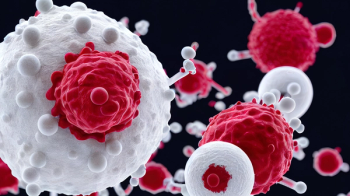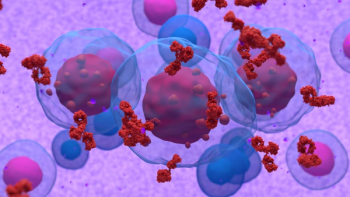
PSMA Response May Indicate Better Metastasis Control in Oligometastatic CSPC
PSMA response was linked to improved metastasis-free survival in patients with oligometastatic castration-sensitive prostate cancer.
Prostate-specific membrane antigen (PSMA) response following stereotactic ablative radiation (SABR) may indicate an improvement in metastasis-free survival (MFS) in patients with oligometastatic castration-sensitive prostate cancer (CSPC) compared with those who did not have a PSMA response, according to data from a retrospective study.
Findings published in Advances in Radiation Oncology demonstrated that the median MFS was 39.9 months in patients who had a PSMA response (n = 92) compared with 12 months in those who did not have a PSMA response (n = 39; P = .001). The 3-year MFS rates were 51% and 33% for PSMA responders and PSMA non-responders, respectively. In the overall cohort, the median MFS was 35.4 months (95% CI, 23.6-47.2), and the 3-year MFS rate was 46%.
Additionally, a multivariable Cox regression analysis showed that PSMA response, as a continuous variable, was associated with MFS when accounting for total PSMA consolidation, disease timing, Gleason grade group, androgen-deprivation therapy (ADT), pre–metastasis-directed therapy (MDT) prostate-specific antigen (PSA) level, and staging imaging (HR, 1.003; 95% CI, 1.001-1.004; P <.001).
“These findings suggest that PSMA-PET response may be an effective radiographic biomarker for distant control following MDT in oligometastatic CSPC. The identification of a PSMA PET response biomarker that correlates with MFS following MDT in oligometastatic CSPC is of particular interest, as MFS has been shown to be a strong surrogate for overall survival [OS] in localized CSPC,” lead study author Philip Sutera, MD, and colleagues, wrote in the journal. Sutera is a radiation oncology resident in the Department of Radiation Oncology and Molecular Radiation Sciences at Johns Hopkins University School of Medicine in Baltimore, Maryland.
The retrospective study included patients with newly diagnosed oligometastatic CSPC who received metastasis-directed SABR and underwent PSMA-PET/CT imaging before and after treatment. Oligometastatic disease was defined as no more than 3 metastases per conventional or PSMA-targeted imaging. Notably, the study included patients who had oligometastatic disease per conventional imaging and polymetastatic disease with 4 to 25 lesions per PET imaging. Concurrent treatment with ADT did not preclude patients from inclusion. Investigators also included patients treated at Johns Hopkins Hospital in the conventionally staged cohort of the phase 2 ORIOLE trial (NCT02680587), as well as patients treated in the PSMA-PET staged cohort of ORIOLE at Baskent University in Ankara, Turkey.
All patients received PET or CT using 68Ga-PSMA-HBED-CC or 18F-DCFPyL-PSMA prior to MDT. SABR was given at doses ranging from 16 to 60 Gy in 1 to 5 fractions; 1 patient received hypofractionated radiation in 15 fractions. Following SABR, patients received follow-up PSMA-PET/CT imaging to evaluate disease response. With the exception of concurrent ADT, no other treatment was given until evidence of disease progression.
Lesion response was classified as a complete response (CR; no residual PSMA activity), a partial response (PR; ≥30% reduction in maximum standardized uptake value [SUVmax]), stable disease (SD; <30% reduction or <20% increase in SUVmax), or progressive disease (PD; ≥20% increase in SUVmax). The primary objective of the study was MFS after SABR in PSMA responders (patients with all lesions in CR/PR) and non-responders (patients with at least 1 lesion classified as SD/PD).
Among all patients included in the study (n = 131), the median age was 66 years (IQR, 60.75-66), and the median PSA at oligometastasis was 4.5 ng/mL (IQR, 1.9-11.8). Seventy-four percent of patients had metachronous disease, and 25.2% had synchronous/de novo disease. Staging was completed through conventional (26.7%) or PSMA-PET (73.3%) imaging. The number of PSMA lesions included 1 (47.3%), 2 (32.1%), 3 (9.2%), or at least 4 (11.5%). Additionally, 87.8% of patients had total PSMA consolidation, and 65.6% of patients received concurrent ADT with MDT. The median duration of ADT was 2 months (IQR, 1.0-3.75).
Furthermore, 48.9% of patients were disease-free long term after treatment, 24.4% experienced oligoprogression, and 26.7% had polyprogression.
The location of the 261 lesions evaluated across 131 patients included node (45.2%), bone (52.5%), visceral (1.1%), and prostate/local recurrence (0.4%). The median SUVmax prior to MDT was 8.7 (IQR, 4.0-16.7) for all lesions, 9.1 (IQR, 4.0-18.5) for nodal lesions, 8.6 (IQR, 4.2-15.7) for bone lesions, and 7.8 (IQR, 6.2-10.2) for visceral lesions. The median biologically effective dose (BED3) was 116.7 Gy (IQR, 90-126) for all lesions, 116.7 Gy (IQR, 90-124) for nodal lesions, 116.7 Gy (IQR, 90-126) for bone lesions, and 378 Gy (IQR, 234-419) for visceral lesions.
Post-treatment PSMA-PET imaging was conducted at a median of 6.2 months (IQR, 4.6-8.7; range, 2.4-10.9) following MDT. PSMA responses included CR (27.6% of lesions), PR (51.7%), SD (14.2%), and PD (6.5%). Notably, 90.7% of untreated lesions (n = 54) were classified as SD or PD. A multivariable logistic regression showed that concurrent ADT was associated with an increased chance of PSMA response in a lesion (odds ratio, 3.04; 95% CI, 1.38-6.70; P = .006).
Additional data showed that the 3-year lesion local control (LLC) rate was 87% for all patients, and the median LLC was not reached. PSMA responders experienced a 3-year LLC rate of 92% compared with 66% for PSMA non-responders. The multivariable Cox regression model showed that as a continuous variable, PSMA response was linked to LLC after accounting for BED3 of SABR, lesion location, ADT, and pre-MDT SUVmax (HR, 1.003; 95% CI, 1.001-1.006; P = .016).
Since the retrospective study’s cohort included patients with varying staging imaging, timing of disease, use of ADT, and metastatic locations, the association between PSMA response and MFS was evaluated in different subsets of patients. A significant association between PSMA response and MFS was found in patients treated with and without ADT; those with metachronous disease; those staged with conventional imaging and PSMA-PET imaging; patients with total PSMA consolidation; and those with lymph node only and bone/visceral metastases. There was not a significant association between PSMA response and MFS in patients with synchronous disease and those with subtotal PSMA consolidation.
Sutera and colleagues noted that the study was limited by its retrospective nature and the heterogeneous cohort of patients. Additionally, varying times of post-MDT imaging could have affected the degree of PSMA responses observed. They also explained that PSA kinetics were not available for these patients, preventing the evaluation of its relationship with PSMA response. They also explained that although MFS has been strongly correlated with OS in localized CSPC, the association between MFS and OS in the oligometastatic setting has not been determined.
“Pending prospective validation, our findings suggest that PSMA-PET should be considered for MDT targeting, evaluating treatment response, and guiding subsequent intervention. Future work is required to further refine our understanding of when post-SABR PSMA-PET imaging should be performed and how best to characterize the PSMA response,” study authors concluded.
Reference
Sutera P, Deek MP, Deek RA, et al. Prostate-specific membrane antigen PET response associates with metastasis-free survival after stereotactic ablative radiation in oligometastatic prostate cancer. Adv Radiat Oncol. 2024;9(7):101507. doi:10.1016/j.adro.2024.101507
Newsletter
Knowledge is power. Don’t miss the most recent breakthroughs in cancer care.
















































































